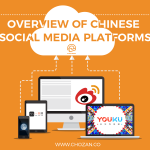Weibo and WeChat are the two largest social networking platforms in China. They both exert significant influence in Chinese society and play an indispensable role in modern life. Weibo provides microblogging services that are the equivalent of Facebook and Twitter combined.
By September, 2016, the number of monthly active users on Weibo had already reached 297 million. WeChat is a mobile application providing instant messaging services. It was first released in January 2011 by Tencent. By September, 2016, the number of daily active users on WeChat had reached 768 million.
For branding on Chinese social media, Weibo and WeChat are definitely the best choices. However, each is best suited to different communication methods and branding purposes.
1. Overall Impact
Communication model and level of exposure
After registering an account, users can post content or push feeds to their subscribers. Relatively speaking, Weibo is a more open platform. Akin to Twitter, even non-account holders can view Weibo posts and its posting default setting is public.
In addition, everyone can also see the reposts, comments or likes.

↑ A Weibo post by the People’s Daily official account with users’ reposts and comments shown publicly below.
Unlike Weibo, WeChat is sort of like a close community.
Normally, WeChat users can only see posts pushed by official accounts to which they subscribe. But they can also search and read posts published by other accounts by inputting keywords in the search bar within WeChat even if they don’t subscribe to them. Generally, WeChat users only subscribe to content they’re interested in so it’s much easier to directly target existing and potential customers in WeChat than in Weibo.

↑ The “Subscriptions” folder in WeChat shows the official accounts you subscribe to and all their push messages.
In WeChat, users only share information with people that they’re close to, like relatives, friends and colleagues so it’s a more private platform that encourages a higher level of interaction and greater motivation to share. If someone shares a post on their Moments (朋友圈) page, this works as powerful word of mouth to their personal networks.

↑ WeChat users share push articles on their Moments page.
Weibo is more suited to mass broadcasting. WeChat, with its higher level of privacy, is more suited to in-depth and exclusive communication, since the messages can be only seen and sent between two parties.
2. Content differences between WeChat & Weibo
Post length
Weibo is designed to be a microblogging site. In the past, regular users’ Weibo posts were limited to no more than 140 Chinese characters and only VIP users could go beyond that. The limit has been relaxed now and any registered user can post up to 2,000 Chinese characters or use the “Article” function, but short posts are still the most common.

↑ An example of a Weibo post from the Astana Expo 2017 official account; a short post with nine photos and hashtags, which gives detailed information about travel to Kazakhstan.

↑ An example of a Weibo article; a review of the movie Duckweed written by a KOL.
On WeChat, the content that users like to repost are multimedia articles with text and photos/audio/video. This makes it a good forum for long, detailed articles to introduce the brand.
When editing articles for WeChat, highlighting the most essential parts is important. Content on the platform is fast-moving so posts needs to be easy to skim. Attractive visuals and well-designed layout are also important to retain readers.

↑ An example of a push article from the LinkedIn official account with elements that make the layout clear and improve readability – a banner image that includes icons, subtitles, bold characters, clearly marked headings and a chart.
Post frequency
On Weibo, there’s no restriction on the number of posts per day and it’s advisable to post regularly to keep a presence in your followers’ feeds. In such a fast-moving consumer goods industry, users can post every hour or two or 3-5 times daily.
For WeChat official accounts, the post frequency depends on the account type :
- For subscription accounts, only one post can be pushed per day but that post can contain up to eight articles.
- For service accounts, users can post four posts monthly. Generally, one to three articles are enough for one day’s feed. Too much information may leave readers overwhelmed.

↑ The official WeChat account of LinkedIn updates every day with one to three articles.
Language style
For branding on Chinese social media, the language style should match the brand image and also suit the platform and audience.
Given that Weibo is not for long-form content and works best to drive traffic to promoted products or services, ensure that posts are concise, interesting and clear. Photos, videos, Biao Qing Bao (表情包, memes) and informative GIFs convey information and act as incentives for readers to repost.

↑ An example of incorporating Biao Qing Bao in a Weibo post: the picture in the middle portraits a popular cartoon character Kumamon, and the words below read “The freezing cold woke me up!”
For longer articles on WeChat, the language style can be more formal, more professional and more detailed.
3. Relationship with the Audience
Interaction with the audience is an indispensable part of branding on Chinese social media. On Weibo, interaction between an account manager and the audience takes various forms:
- Liking: Account managers may “like” a post that showcases their brand or that speaks highly of its products or services. This shows appreciation and gratitude while drawing attention to the post.
- Comments: Account managers may comment on a user’s post or reply directly to his/her comment.
- Reposts: Account managers can repost a KOL’s (key opinion leader’s) post about their brand or repost general users’ positive testimonials and questions with a response.
- Messages: This is a more private form of interaction as only the sender and account manager can see the messages. This kind of communication is primarily used as a form of customer service – to deal with complaints and to help customers solve problem.

↑ The message function in Weibo allows accounts to send automated and personal messages to their followers and allows followers to contact the brand account with feedback and enquiries.
WeChat is a semi-closed platform so the interactions between the account manager and the user are more personal.
- Direct messages: Users can send a message to the official account. If the message contains certain key phrases, they may get an auto-reply or there may be a personal response from an account manager.
- Liking and comments: WeChat users can leave comments on articles that official accounts publish or click the “Like” button at the end of the article. Account managers can select high-quality comments to show at the bottom of the article and reply to them, so that other readers can see the selected comments and replies

↑ Account managers can feature high-quality comments and reply to them.
Marketing Strategy
No matter which platform you plan to choose to start your branding on Chinese social media, high-quality content that users repost is the most important element. Unique, rich, interesting content helps to keep subscribers attracted loyal followers. This requires focus and sustained effort.
In addition to quality content, the following ingredients are key to an effective marketing strategy.
KOL (Key Opinion Leaders)
Key opinion leaders in China, play an important role in both Weibo and WeChat marketing. They’re bloggers, celebrities, authorities or professionals in a certain industry that have a huge number of followers.
On Weibo, they’re usually paid to produce original Weibo posts related to the promoted products or services, repost a brand’s posts or co-organize online activities with brands. The social influence of KOLs is enormous. KOLs not only encourage followers to repost and comment but also help to convert them into customers.
On WeChat, KOLs have official accounts with lots of subscribers. This means their posts are reached by a large, loyal audience. The most common form of cooperation with KOLs involves sponsored content creation. Brands find a KOL who likes their products and is a good fit for them. They then negotiate and arrange for them to write promotional articles and recommend their products or services.
Unlike in some other jurisdictions, these posts do not need to be marked as “sponsored”. The content is often advertorial in nature with the reader not aware until the end of the article that it is, in fact, promotional.

↑ Yansubagua (严肃八卦) is a well-known official WeChat account that publishes celebrity gossip and entertainment news. Many brands have cooperated with the account manager to produce promotional material because of its huge subscriber base. For example, the article above starts with information about movie star Aarif Lee and ends with a purchase link for a jewellery brand. Readers can’t tell from the headline that this is an advertisement.
Following hot topics or festivals
Following hot topics is also very common in branding on Chinese social media. If account managers can develop interesting posts related to the most popular issues, the account will stand out and gain popularity. For Weibo, account managers can also add hashtags to increase searchability.

↑ On February 14th, most WeChat official accounts push Valentine’s Day-related content, including Guoku, a goods recommendation platform, and The Bund, a digital magazine based in Shanghai.
Interactive online campaigns
Campaigns are another important aspect of Weibo marketing. Users like to take part in interesting, creative campaigns, especially when a prize is on offer. For example, in return for reposting or liking your content or submitting original content, users can get a chance to win a prize. This is an effective way to generate traffic and gain popularity.
(For more detailed information on Weibo campaigns, please refer to our post: Weibo Marketing: Campaigns and Why We Use Them)
WeChat online campaigns are different from those on Weibo. WeChat doesn’t provide any official campaign formats but account managers can still run campaigns encouraging readers to repost to their Moments page or to their friends to win a prize. They can also give their audience useful resources or design H5 pages for events, brand promotions, product introductions and more.
Conclusion
Because of Weibo’s open, public nature, the relationship between its users is not that strong. Users don’t have to follow a certain account to read its posts. However, information on Weibo changes frequently and spreads exponentially. In this sense, Weibo is a particularly good choice for brands that want to increase their corporate exposure, build their brand image and launch marketing campaigns.
WeChat maintains a relatively intimate relationship with and between its users since most WeChat contacts are friends and acquaintances. In addition, users generally only subscribe to official accounts that push content they’re interested in. As a result, it’s more efficient to target current and potential customers on WeChat. What’s more, the instant messaging function allows users to contact the brand directly so WeChat is also well-suited to sales conversion and customer services functions.
In sum, for branding on Chinese social media, Weibo and WeChat each have their advantages. You don’t have to make an either-or decision right away. Instead, we suggest you use both platforms and make full use of their respective strengths to set up your marketing strategy.
Do you want to learn more about the features and functions of Weibo and WeChat? Do you know how to grow followers on Weibo and WeChat? Do you know which WeChat official account suits you best? Leave a comment below. We’d be happy to answer any questions you may have.
To get deeper insights into Chinese social media marketing and utilizing it to serve your business, join ChoZan, a training and resources platform for Chinese social media marketers.
Please follow our official WeChat account to get more updates about the latest news, feature updates and case studies.

Share this article on your favourite social media
Read more related posts
-
All You Need to Know About Fake Accounts on Chinese Social Media
Some companies have resorted to exploiting the use of fake accounts on Chinese social media, in an attempt to promote products, establish a good brand reputation, deal with public relations…
-
Chinese Social Media Platforms: A Comprehensive Overview of the Top Performers
China is a large market with a total population of over 1.3 billion people. As of December 2016, the number of Chinese netizens was over 730 million, almost equivalent to…
-
All You Need to Know About Fake Accounts on Chinese Social Media
Some companies have resorted to exploiting the use of fake accounts on Chinese social media, in an attempt to promote products, establish a good brand reputation, deal with public relations…
-
Chinese Consumer Behavior Overview
Chinese consumer behavior seems to change faster than in other markets. Increasing exposure to and integration of social media in daily life play a significant role in this rapid change.…
-
How to Sell on WeChat?
With more than 889 million monthly active users and 200 million of them linking their WeChat account to bank cards, there’s no doubt that WeChat is a major player in…








